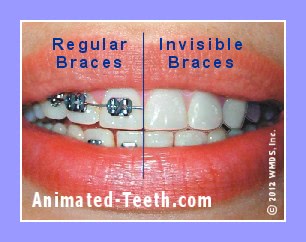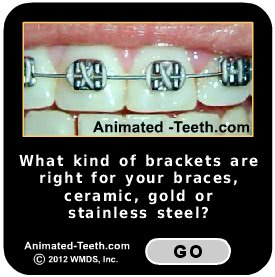Cost of orthodontic treatment, by system type.
There are a number of different orthodontic systems that can be used to correct a person’s smile. And deciding among them can be a difficult task.
In many cases, the treatment’s overall fee is a major factor in deciding which method is chosen. This page can give you an idea of the comparative costs of the most frequently used types of orthodontic systems. We have included pricing information for:
- Clear aligner systems – Invisalign® / ClearCorrect® / Invisalign Express®
- Direct-to-consumer clear aligners – Simile Direct Club®
- Lingual braces – iBraces®, Incognito®, In-Ovation® L, Harmony®
- Conventional metal braces. – Silver-colored brackets and wires.
- Ceramic braces (brackets) / Gold braces / Fashion brackets
- Orthodontic retainers – Permanent (fixed) / Removable
This page also provides information about dental insurance coverage for braces. What can you expect?
a) Fees for Invisalign®.
The fee that a dentist charges for a case that they treat using the Invisalign® system will probably be about the same as what they charge for traditional braces. In some cases, it might be more. It’s unlikely that it would be less.

A comparison of Invisalign® and traditional braces.
Invisalign® dental braces –
Considering that the $5000 number is an “average” price, and with inflation factored in, you can expect your treatment costs to fall into the following range.
- $3500.00 to $8500.00
Low fee = Small rural city or town.
High fee = Large metropolitan area.
[How we calculate our cost estimates for procedures.]
More information.
If you’re unfamiliar with Invisalign®, use this link where we describe this system, as well as the advantages and disadvantages of using it. Pros / Cons
FYI – How much does your dentist pay for an Invisalign® case?
We noticed a document on an Align Technology, Inc. website that suggested that the typical price a dentist pays, per patient case, is on the order of $1,550 (2010).
That’s generally more than a dentist’s cost of materials when treating a case with conventional braces. However, treating a case conventionally is substantially more labor intense for the dentist (more and longer patient appointments).
How much does ClearCorrect® cost?
At least a part of the marketing strategy of ClearCorrect, Inc. (the makers of an Invisalign® equivalent) seems to be keeping the pricing of their system low. That suggests that dentists who use this system should be able to charge less.
b) Fees for Invisalign Express®.
In a nutshell, Invisalign Express® is essentially a scaled-down version of the standard Invisalign® system. It provides a way for a dentist to minimize their costs so they can, in turn, treat less complex orthodontic cases at a lower price.
By definition, each Invisalign Express® case only involves the use of ten or fewer sets of aligners (standard cases typically involve twenty to thirty sets) and it’s only intended for treating simple cases.
Invisalign Express® dental braces –
- $2500.00 to $4700.00
More information.
Use this link for more information about Express® and how it differs from standard Invisalign®. Application differences.
FYI – How much does your dentist pay for an Invisalign Express® case?
According to information we noticed on one of Align Technology, Inc.’s websites, a dentist’s cost for the Invisalign Express® system is roughly $900 per case (2010), a little more than half the cost of standard Invisalign®.
Similar products – Simpli 5®.
AOA Orthodontic Laboratory, Inc. manufactures two clear plastic, removable tooth aligner systems that can be used to treat cases similar to those treated with Invisalign Express®. They are the Simpli 5® and Red White & Blue® systems.
These products cost the treating dentist less than Invisalign Express®, so in those cases where they can be used, the patient’s costs might be reduced. For more information, use this link: Simpli 5® / Red White & Blue® Applications vs Invisalign®.
c) Fees for Smile Direct Club® (direct-to-consumer aligners).
A relatively new option for orthodontic treatment is a form of do-it-yourself clear aligner therapy where you initiate, perform and monitor your treatment process with limited oversight by a professional.
The leading provider for this type of service is Smile Direct Club®. Other similar products are SmileLove®, Candid®, SnapCorrect®, AlignerCo®, Byte aligners® and you would expect their cost to be similar.
Smile Direct Club® dental braces –
- $1895.00
Other types of braces.
Removable orthodontic systems (like Invisalign®, ClearCorrect®, Invisalign Express®) don’t always make the best treatment choice. Reasons why. After completing their evaluation, your dentist may determine that one of the bracket-and-wire systems discussed below offers advantages that the above aligner systems cannot.
d) Fees for conventional metal braces.
We’re using the term “conventional braces” to refer to the treatment method where:
- Metal brackets are bonded onto the front or cheek side of the patient’s teeth.
- The brackets and wires used are silver in color.
- The wire is held in place using elastic (“rubber”) bands.
Conventional dental braces –
- $3500.00 to $8000.00
More information.
Wearing conventional braces doesn’t have to be as drab and boring as you might think. Here’s are some ways they can be dressed up. Individualize your look.
e) Fees for Lingual braces (Incognito®, iBraces®, In-Ovation® L, Harmony®).
- Lingual braces are similar to conventional ones in the sense that they’re made up of brackets and wires.
- They differ by the way they are placed on the backside of the teeth, where they aren’t as visible.
Lingual dental braces –
- $6000.00 to $13000.00
Why do lingual braces cost more than conventional dental braces?
Lingual braces usually cost about twice as much as conventional ones in part due to the cost of materials and lab services involved. (Ling)
- The brackets and wires that are used with conventional braces are mass-produced, stock items.
- In comparison, with modern lingual systems the hardware used is custom made for each individual patient by a dental laboratory using sophisticated computer-aided cad/cam technology and robotic wire-bending technique.
A cost-cutting alternative for Lingual braces patients.
When the option is offered by their dentist, some patients choose to have lingual braces placed only on their upper teeth (the teeth that show the most) and then conventional ones on the front side of their lowers (the teeth that are more difficult for people to see).
More information.
Use this link for more information about lingual braces. Pros / Cons
f) Fees for Ceramic braces (Clear braces).
This treatment option refers to conventional braces, where the dentist places clear or tooth-colored ceramic orthodontic brackets instead of metal ones. Only the brackets are different, a metal wire is still used.
Which makes the best choice for you, gold, ceramic or traditional braces? Click the image to learn more.
Ceramic dental braces –
- $3500.00 to $8500.00
Why do ceramic braces cost more than metal ones?
- One involves the cost of the brackets. They may cost several times more than their stainless steel equivalents. However with some brands, the price difference is quite small.
- Beyond the cost of materials, using ceramic brackets often involves a longer treatment time or increased treatment difficulties. Here’s why.
Cost-saving approaches.
As a cost-cutting measure, some patients decide to have ceramic brackets just placed on those teeth that show the most. This may mean only their upper teeth, or even possibly just their center six.
Those teeth that don’t receive tooth-colored brackets get metal ones. And while the idea of this mismatch may be a concern for some initially, once it’s demonstrated to them how comparatively little the teeth with the metal brackets show during normal function, they are usually fine with it.
Ask if “coated” archwires will be used.
White-colored “frosted” or “coated” archwires can help ceramic braces blend in even better. If this option is chosen, you can expect that your expenses will be somewhat greater.
More information.
Use this link for more information about ceramic braces. Pictures
g) Gold braces / Fashion brackets.
Rather than using silver-colored brackets, gold or uniquely shaped “fashion” brackets (hearts, stars, flowers, etc…) can be placed.
Conventional dental braces using gold or fashion brackets –
- $4000.00 to $8500.00
Cost-cutting measures.
As a cost-cutting measure, fashion brackets are usually only placed on a patient’s center four or six upper front teeth. Gold brackets may just be placed on selected teeth too, like the upper and lower front ones. After all, why dress up teeth that are hard to see?
You’ll have to ask exactly how much added expense is involved. And it may not be as much as you expect. Specialty brackets can cost several times as much as their standard counterparts but this isn’t always the case (“generic” equivalents do exist).
Unlike when choosing ceramic braces, metal specialty brackets shouldn’t significantly affect or complicate your treatment process.
Will gold archwires be used with your gold braces?
In the case where gold brackets are placed, ask if gold-colored archwires will be used too. If so, you can expect that that “extra” will add to your overall treatment expenses too.
More information.
These pages discuss the topic of specialty brackets in greater detail: What are gold braces? Pictures. / What are fashion brackets? Examples.

Our affiliate links can be used to shop for Invisalign accessories on Amazon.com
They offer many innovative devices and solutions for issues Invisalign® wearers encounter.
Dental insurance coverage for orthodontic treatment.
Dental insurance policies vary greatly, so it’s impossible for us to provide any type of definitive answer regarding coverage for braces. However, the following information frequently applies.
How insurance policies often read.
- Many policies state that they’ll pay 50% of the cost of orthodontic treatment per covered individual.
- There’s frequently a maximum limit (which is often on the order of $1500 to $3000).
- There may be an age limit restriction that applies (as in coverage is provided for children, or possibly teenagers through age 18 but not adults).
- The “maximum limit” is typically a lifetime one, meaning that once benefits have been exhausted there are no further benefits available for re-treatment later in life.
Are non-conventional treatment methods covered?
In regard to non-traditional braces (i.e. Invisalign®, Invisalign Express®, iBraces®, etc…) and treatment variations (i.e. ceramic braces, gold braces, fashion brackets):
- If an insurance policy does provide coverage for “orthodontic treatment,” there is typically no limitation about which specific technique is utilized.
(So yes, benefits usually apply.)
Page references sources:
Because the procedure estimates we show are developed by different means, you may find the survey of dental fees published by DentistryIQ an interesting independent source: DentistryIQ – 2017 dental fee analysis by region and CDT procedure code
Ling P. Lingual orthodontics: History, misconceptions and clarification.
Invisalign.com. How much does Invisalign cost?
SmileDirectClub.com. How much does Smile Direct Club cost?
All reference sources for topic Orthodontic Treatment.
